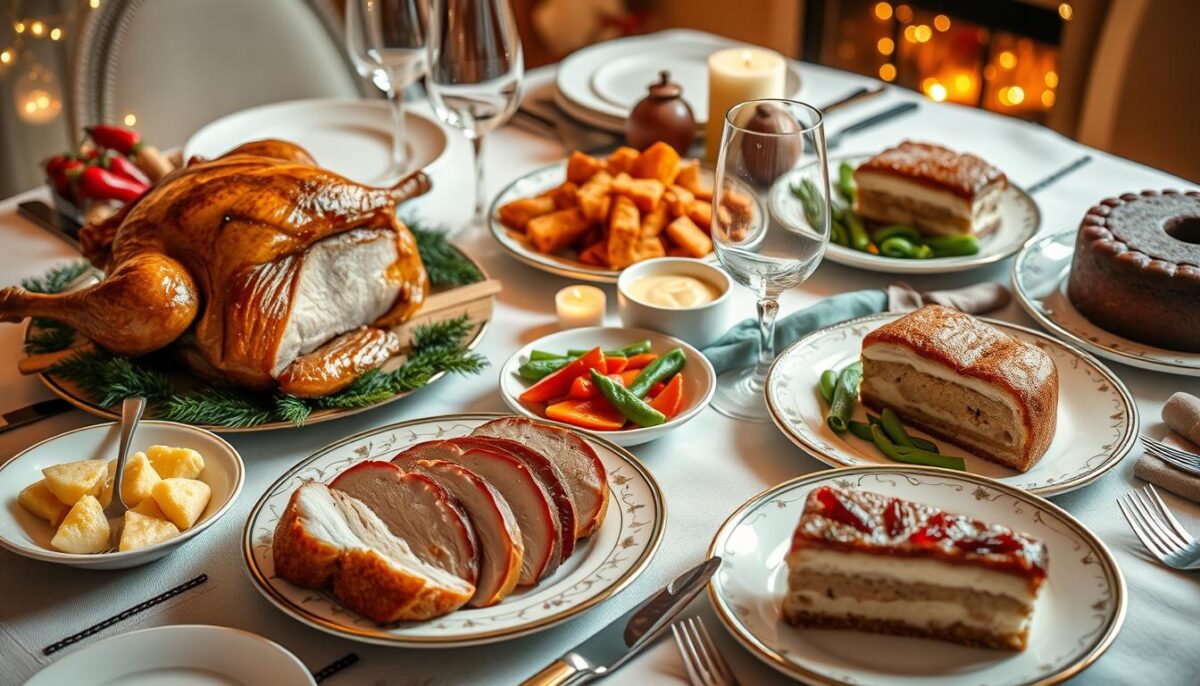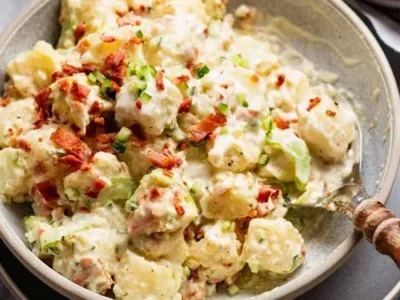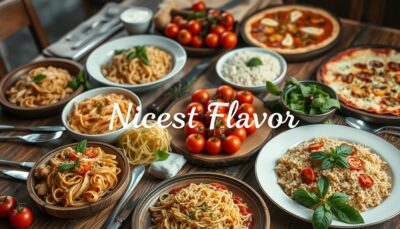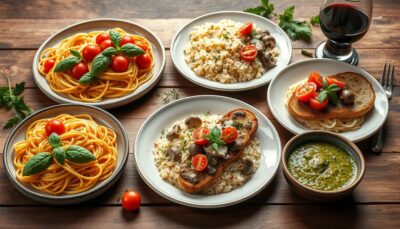As the festive season approaches, France’s rich culinary heritage comes alive. The aroma of traditional food Christmas dishes fills the air. But what makes these iconic holiday meals so special?
What secrets lie behind the flavors passed down through generations? These flavors shape France’s cultural fabric, making it a gastronomic powerhouse.
Join us on a delicious journey through French Christmas cuisine. Here, regional specialties and time-honored recipes come together. They create a symphony of flavors that go beyond time and space.
From the countryside’s rustic delights to the city’s refined elegance, we’ll explore it all. We’ll uncover the stories behind these beloved holiday dishes. These stories reveal the traditions and quality that make them special.
Key Takeaways
- Discover the rich cultural heritage that shapes the diverse regional specialties of French Christmas cuisine.
- Explore the time-honored recipes and traditional food cooking methods that have been passed down through generations.
- Understand the importance of local ingredients in creating the unique flavors that define authentic French Christmas dishes.
- Appreciate the artistry and attention to detail that goes into crafting these culinary masterpieces.
- Gain a deeper understanding of the gastronomic diversity that makes French Christmas cuisine a true celebration of the senses.
Unveiling the Captivating World of French Christmas Cuisine
Start a food journey through France’s diverse regions. Here, the cultural heritage and culinary traditions of Christmas shine. From the Alps to Bordeaux, each area has its own regional cuisine. These dishes reflect the ancestral recipes and ethnic flavors of past generations.
Regional Specialties: A Gastronomic Journey
In Alsace, Christmas is celebrated with foie gras and choucroute garnie. This sauerkraut dish is topped with smoked meats. In Provence, the gastronomic diversity is seen in the 13 Desserts. These sweets honor the region’s rich agriculture.
Normandy is known for its creamy gratin dauphinois and rich boudin noir. This blood sausage adds a unique flavor to holiday meals.
Cultural Traditions: Ancient Recipes Passed Down Through Generations
The cultural heritage of French Christmas is in its ancestral recipes. Families prepare the bûche de Noël together. This yule log cake represents the changing seasons and the year’s passage.
The ethnic flavors of France are celebrated in pain d’épices. This spiced bread fills homes with cinnamon, ginger, and anise scents.
The gastronomic diversity of French Christmas cuisine is a treasure. It shows the country’s rich cultural heritage and enduring culinary traditions. These traditions delight our senses and warm our souls.
Traditional Food: Authentic Dishes Steeped in Flavor
Exploring French Christmas cuisine reveals a world of traditional dishes. These dishes are filled with authentic flavors and are deeply rooted in France’s culinary history. They offer a peek into the heart of French food culture.
The Bûche de Noël, a decadent yule log cake, and the savory Foie Gras, a luxurious pâté, are just a few examples. Each dish tells a story of France’s culinary traditions.
French Christmas cuisine is also known for its regional specialties. These dishes use local ingredients and traditional techniques. They create a rich tapestry of flavors and cooking styles. Let’s look at some of these dishes:
- In Alsace, the Choucroute de Noël is a favorite. It’s a hearty dish of sauerkraut, smoked meats, potatoes, and spices.
- Along the southern coast, the Thirteen Desserts of Provence celebrate Christmas. It’s a mix of sweets and dried fruits, honoring the region’s agricultural traditions.
- In Burgundy, the Coq au Vin is a symbol of Christmas comfort. It’s a chicken dish cooked in a rich red wine sauce.
These traditional foods are made with care and respect for local ingredients. They show France’s commitment to preserving its culinary traditions. Each bite is a celebration of France’s rich food heritage.

“The true essence of French Christmas cuisine lies in its regional specialties, where local ingredients and ancestral techniques come together to create a tapestry of ethnic flavors and indigenous cooking.”
| Dish | Region | Key Ingredients |
|---|---|---|
| Bûche de Noël | National | Sponge cake, chocolate, cream, decorations |
| Foie Gras | National | Goose or duck liver, spices, wine |
| Choucroute de Noël | Alsace | Sauerkraut, smoked and cured meats, potatoes, spices |
| Thirteen Desserts | Provence | Assorted sweets, dried fruits |
| Coq au Vin | Burgundy | Chicken, red wine, mushrooms, bacon, pearl onions |
Local Ingredients: The Secret to Exquisite Taste
At the heart of France’s Christmas cuisine is a deep love for local ingredients. Fresh produce and artisanal delicacies are key. They make traditional French holiday dishes truly special.
From Farm to Table: Celebrating the Bounty of the Land
Exploring France’s culinary traditions shows a strong bond between land and table. The changing seasons guide the ingredients in our festive meals. This ensures each dish celebrates the region’s unique flavors.
For example, the juicy roasted chestnuts from the Ardèche or the creamy Brie de Meaux from the Île-de-France add authenticity to every bite.
Ancestral Recipes: Timeless Culinary Treasures
The flavors of French Christmas cuisine come from great ingredients and old cooking techniques. Recipes like the Bûche de Noël and foie gras are passed down through generations. They reveal the true essence of French holiday food.
By honoring these recipes, we keep alive the rich cooking traditions of France. This preserves the festive spirit of the country.
FAQ
What are the traditional French Christmas dishes?
French Christmas dishes are a mix of local specialties and old recipes. They show the country’s rich food culture. Dishes like Bûche de Noël, Foie Gras, and Oysters Rockefeller highlight French flavors and traditions.
How do local ingredients shape the unique flavors of French Christmas cuisine?
Local ingredients are key to French Christmas dishes’ taste. Chefs use seasonal produce and traditional methods. This creates dishes that truly reflect France’s diverse food culture.
What is the significance of ancestral recipes in French Christmas culinary traditions?
Ancestral recipes are France’s culinary treasures. They bring back authentic flavors and cultural heritage. By keeping these recipes alive, French families honor their culinary history.
How do regional specialties contribute to the diversity of French Christmas cuisine?
Regional specialties make French Christmas cuisine rich and varied. Each area has its own dishes and traditions. This variety creates a flavorful journey through France’s gastronomy.
What is the cultural significance of traditional French Christmas dishes?
Traditional French Christmas dishes are deeply rooted in culture. They preserve France’s culinary heritage. By enjoying these dishes, French people celebrate their shared food traditions and history.







